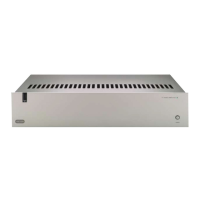supply pin currents are half wave-rectified
versions of the drive current of the amplifier.
This causes the voltage gain, which is buffered
and passed on to the outputs. The feedback
from pin 1 of IC101 acts to reduce the gain of the
amplifier; when this current is roughly equal to
the current required to drive the input signal into
44-ohm’s equilibrium is reached and the closed
loop gain is defined. The output stage provides
the vast majority of the current required to drive
the 44-ohm load. The op-amp only needs to
provide a very small error current to give the
required voltage magnification.
Transistors TR101 and TR116 are common base
amplifiers their purpose is to provide the +/- 15v
rails necessary to drive the op-amp whilst
allowing the power supply currents that are
drawn to pass through into the Wilson current
mirror stage, this is formed by PNP transistors
TR102, TR104 and TR122 the NPN mirror is
formed by TR115, TR117 and TR122.
TR103 combines the two current mirrors to
provide a very high-gain current to voltage
(transresistance) gain stage roughly 80dB at low
frequency C114 and C132 with R149, R150
combine to give a open-loop pole at roughly
10Khz and a corresponding open-loop zero
around 500Khz. This allows for good time
domain performance and clean square wave
reproduction with no sign of ringing or overshoot.
Diodes D100 and D101 act to limit the current
through TR115 and TR112, if the input current
exceeds 14mA the diodes conduct and the
transresistance stage becomes a constant
current source killing the open loop gain and
preventing damage to the transistors.
IC101 forms a D.C intergrating servo. Its
purpose is to remove residual D.C errors due to
slight device mismatch and component
tolerances. It is configured as an inverting
intergrator with a time constant of <0.5 seconds.
Any D.C offset at the output of the amplifier will
cause the output if the op-amp to go negative
increasing the current in the negative supply pin
and thus pulling the output down to ground (and
vica versa). D108 protects the inverting input of
the op-amp under fault condition.
TR103 provides a 4.7v bias voltage to allow
the following pre-driver stage to operate in
Class A.
TR123 and TR125 form a Class A pre-driver
emitter follower stage to boost the current gain
and isolate the transresistance stage from the
output transistors. TR105 and TR118 act as a
30mA current limit and prevent the destruction
of TR123 and TR125 under a fault condition.
R109, R164, R110 and R165 loosely decouple
the emitters of TR123 and TR125 from the
output stage.
TR128, TR129 and TR126, TR127 are Sanken
SAP 15N and SAP 15P Bi-polar output drivers
RV100 is the Bias adjust preset D104 protect
the Output drivers from destruction if RV100
goes open circuit.
C144 to C147 provide local R.F stability and
prevent oscillation. D111 and D112 are catch
diodes to reduce the effects of back-EMF from
the loudspeaker coils/load.
R164, R183, C150 and L100 form the Zobel
network, these components ensure that the
amplifier sees a constant load of 4.7 ohms at
high at very high frequencies and improve
stability – reduce H.F noise. L100 and R183
decouple the load at high frequencies to
ensure amplifier stability into capacitive loads.
SAP 15NY SAP 15PY
S-E 0.22 Ohm
SAP
Under output driver failure conditions the 0.22 internal
emitter resistor will usually go open, the resistor should be
measured between pins S and E.

